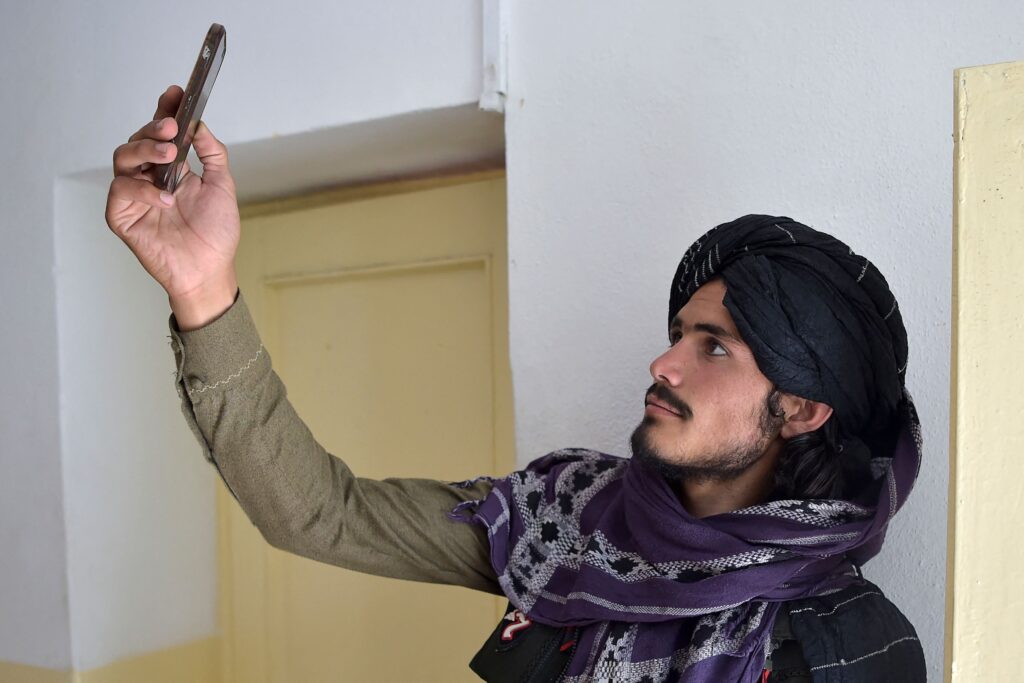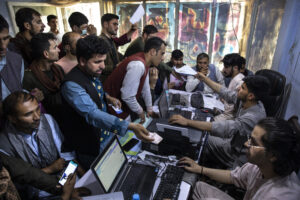BRAD D. WILLIAMS
 WASHINGTON: As the Taliban swept across Afghanistan in recent months, the militant group reportedly destroyed dozens of communications antennas, power pylons, and other infrastructure critical to supporting the country’s rudimentary communications networks, raising the specter of Afghanistan “going dark.”
WASHINGTON: As the Taliban swept across Afghanistan in recent months, the militant group reportedly destroyed dozens of communications antennas, power pylons, and other infrastructure critical to supporting the country’s rudimentary communications networks, raising the specter of Afghanistan “going dark.”Were the Taliban to destroy or shut down the country’s networks, it could seriously impede US efforts to conduct electronic surveillance and signals intelligence (SIGINT) to track the new government and many of the terrorist organizations it will likely harbor.
But whether the Taliban will, in fact, destroy or shut down the country’s domestic networks remains to be seen. The Taliban has, in recent weeks, taken a page out of other terrorist organizations’ playbooks and used the internet to great effect in spreading propaganda.
The Taliban now faces a decision: Shut down the country’s networks, while hindering its propaganda and other online activities, or leave them intact, allowing an avenue for continued US electronic surveillance.
Notably, late last week, the Taliban’s official websites, in multiple languages, all disappeared offline. It’s unclear right now who might have been behind the website takedowns, but it’s unlikely the Taliban shuttered its own sites, given their recent value in spreading propaganda. (US Cyber Command and the National Security Agency both declined Breaking Defense’s request for comment on the matter.)
US surveillance of Afghan networks has, for the past two decades, been significant. NSA files leaked in 2013 by former contractor Edward Snowden contained information on Boundless Informant, a tool NSA used to track global surveillance and which showed Afghanistan to be among the most heavily surveilled foreign countries by the US. Because the country has been an area of active conflict, the focus and intensity of intelligence activities are not surprising, and the US will be keen to retain as much capability as possible to continue monitoring the Taliban’s and other terrorist groups’ communications.
Given the US has now closed its military bases and embassy in Afghanistan — along with the majority of intelligence operations based out of those locations — losing networks as a source of intelligence would be a major blow to the military and Intelligence Community.
Back to the Dark Age?
Should Afghanistan “go dark,” it would be a return to the recent past. During the Taliban’s first rule over the country, from 1996 to 2001, the internet was banned. The Taliban governed by relying heavily on written communications, couriers, and walkie-talkies.
Of course, 25 years ago, the World Wide Web was still in its early years, and the country had not begun to move online in any meaningful way when the Taliban first came to power. That hardly any internet infrastructure existed made an internet ban much easier then. Indeed, the World Bank said that zero percent of the Afghan population was online in 2001.
But things have changed over the past two decades. To be sure, Afghanistan is still far behind many countries in terms of modern communications infrastructure and the number of its citizens online. The Central Intelligence Agency’s most recent World Factbook says that, in 2020, approximately 13.5 percent of the country (roughly 4.7 million people) have internet access and about 22.5 million have mobile cellular service. Afghans who are online, including the Taliban, rely heavily on social media, email, and messaging apps. One factor inhibiting greater online presence of Afghans is a low literacy rate, which the World Bank in 2015 estimated to be just 43.02 percent of Afghans over the age of 15.

Afghans crowd into the Herat Kabul Internet cafe to apply for the SIV program on August 8, 2021 in Kabul, Afghanistan. (Paula Bronstein/Getty Images)
Should the Taliban shut down networks, there are alternative options to spread its messages. For decades, the Taliban has used “night letters” (shabnamah) to communicate with target audiences. These are hand-written communications delivered by human couriers, sometimes posted in local mosques. Naturally, this system bypasses digital and electronic means of delivery, making it nearly impossible to gather intelligence from night letters without human assets on the ground.
(Asked about the possibility of the Taliban resurrecting night letters as a primary method for government communication, the NSA declined to comment.)
The Internet’s Central Role in 21st Century Terrorism
Still, the prospect of Afghanistan going dark might be overstated. The rapid collapse of the Afghan security forces and the US-backed Afghan government has been a propaganda windfall for the Taliban and other global terrorist organizations, and the organization is savvy enough to want to use that to its advantage.
“It’s huge,” Paul Cobaugh, an Army veteran and vice president of Narrative Strategies, told Breaking Defense about the propaganda win for the Taliban. Cobaugh joined the Army in the 1970s and then rejoined 26 years later as a Warrant Officer specializing in counterterrorism, serving tours in Afghanistan every year from 2009 to 2013.
“What we don’t realize that the Taliban keeps showing us,” Cobaugh said, is that, “It’s always been an influence war. This has always been about opinion, public opinion.”
If pictures that have emerged during the country’s dramatic fall are any indication, the Taliban represents a significant slice of the Afghan population that does use modern communications. Pictures of the Taliban inside the presidential palace on Aug. 15 showed many militants snapping photos, shooting videos, and making calls with smartphones. Some have observed that Taliban members have proven to be “sophisticated” social media users, managing to remain on Twitter after overthrowing a US-backed government even while a former US president is banned from the platform for life.
“The Taliban do influence from the day they’re born. They get it. They’re good at it,” Cobaugh said. “They understand a lot about what we don’t in the West, which is how to actually analyze the target audience so they can influence predictably. They know their audience intimately.”
Over the past decade, terrorist groups have used the internet — and social media, in particular — as a central platform for propaganda, recruiting, operational planning, and other purposes. While terrorists have at times defaced websites, the groups have not, historically, shown anywhere near the offensive cyber capabilities that countries such as Iran, Russia, and China possess.
So, while the Taliban has in the past sought to suppress online activities, global terrorist online operations have changed significantly since the Taliban last ruled. Which means, once again, the key question is whether the Taliban feels it gains more benefit from taking down the networks or leaving them online.
“They’ll go dark in some areas of operations, most likely, and that’s just for their own good, so they can operate with less scrutiny,” Cobaugh said. “But I don’t see how in the world they’re going to try to run a country now without the internet. There will probably be foreign powers, Russia and China types, that will be assisting them on the technical end of things. I have no doubt about that.”
China is already there: The Afghan Ministry of Communications in 2006 announced that Chinese telecom company ZTE, which has been banned by the US and other Western countries over concerns about security flaws in the equipment that could allow espionage, would build a nationwide fiber-optic network. In recent years, China has stepped up its investments in Afghan networks, including a fiber-optic link between the two countries.
So the Taliban very well may give pause to flipping the off-switch for all Afghan networks because, in the Taliban’s view, the propaganda upside could outweigh the surveillance downside.
“They are promoting a full-scale [public relations] campaign at the moment, for a variety of reasons,” Cobaugh said. “They cannot do that without connectivity to the outside world.”
No comments:
Post a Comment